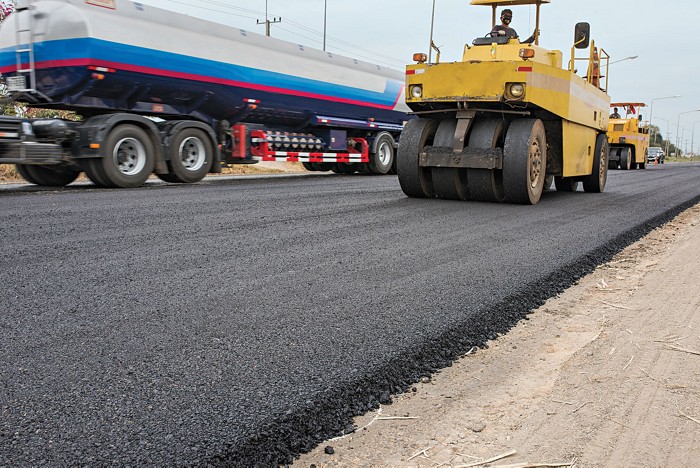7 Easy Facts About A1 Professional Asphalt & Sealing Llc Explained
7 Easy Facts About A1 Professional Asphalt & Sealing Llc Explained
Blog Article
Not known Facts About A1 Professional Asphalt & Sealing Llc
Table of ContentsUnknown Facts About A1 Professional Asphalt & Sealing LlcThe smart Trick of A1 Professional Asphalt & Sealing Llc That Nobody is DiscussingThe Buzz on A1 Professional Asphalt & Sealing LlcSee This Report about A1 Professional Asphalt & Sealing LlcRumored Buzz on A1 Professional Asphalt & Sealing Llc

The oil in a vehicle engine is not just oil. It includes a variety of additives to enhance the car's performance. These consist of polymers, thickness modifiers, warmth stabilizers, additional lubricants, and wear ingredients. The REOB contains all the ingredients that were in the waste oil along with the wear metals from the engine (mostly iron and copper).
However, by making several blends utilizing different REOB samples and different asphalt binders, the variants largely can be balanced out. Several States gave examples of well-known REOB composition to TFHRC researchers, who assessed the samples to compare the percentage of included (recognized) REOB to the found (evaluated) amount. The evaluations showed an equivalent portion of included and found REOB.
More About A1 Professional Asphalt & Sealing Llc
None of those States recognized that the asphalt they were acquiring consisted of REOB. One State insisted its examples had no REOB - https://www.intensedebate.com/people/a1asphaltseal.
Of the 1,532 examples checked, 12 percent consisted of REOB, and some contained appreciably high degrees of it at 1020 percent. The greatest level was 34 percent in an example from Texas, which TxDOT had used in a patching substance. This testing also disclosed the visibility of phosphoric acid in 11 percent of the samples, and 2 percent consisted of ground tire rubber.
2 years back at TRB's annual meeting, the Federal scientists held an REOB workshop and provided the searchings for of their lab examinations to a standing room-only crowd. Some firms do not particularly outlaw REOB, they do impose physical examinations that preclude its useeffectively a ban. Others do not outlaw it by spec, yet have contracts with asphalt distributors to prevent making use of REOB
The Basic Principles Of A1 Professional Asphalt & Sealing Llc
A handful do permit REOB, some within particular limits. Ohio and Texas limit levels to less than 5 percent of the asphalt. To develop a trustworthy examination approach that all States can use, the TFHRC researchers established a round-robin test plan. The participants are 11 State highway agencies (Illinois, Massachusetts, Minnesota, Mississippi, Montana, North Carolina, Oklahoma, South Carolina, Texas, Vermont, and Wyoming), 2 independent testing laboratories, the Ministry of Transportation in Ontario, Queen's University in Ontario, and an Ontario paving professional.
The individuals are checking the samples independently using the guidelines given by the TFHRC scientists. The output will certainly be a recommended AASHTO examination technique that any State can embrace and use.
The sidewalk with REOB, which lies 0.6 mile (1 kilometer) from the sidewalk without REOB, has similar subgrade, traffic thickness, and climate. Nonetheless, the section of Highway655 with 5 to 10 percent REOB showed substantial cracking. In this instance, the existence of REOB was the determined reason for cracking at a reduced temperature levels.
"In our experience in Canada, also tiny amounts of 23 percent can be a problem." A section of test sidewalk in Minnesota (MN1-4) located to consist of REOB likewise cracked too soon. The sidewalk done weblink well for the very first 3 to 4 years, yet then started to split. This sidewalk is likewise based on low temperatures.
What Does A1 Professional Asphalt & Sealing Llc Mean?
The examinations were not extensive, yet they showed that at levels of 6 percent or even more, the tensile strength of the asphalt dropped considerably. At a degree of 3.5 percent REOB, the variant in the physical examination techniques was more than the effect of REOB. It was tough for researchers to evaluate whether REOB was present. https://pxhere.com/en/photographer/4237412.

One binder parameter taken into consideration is the difference between the low temperature level essential spec temperature level for rigidity (S) in the bending beam rheometer and the bending beam of light rheometer creep slope (m-value) kept in mind as Tcritical. TC = TC (S) TC (m-value). Analysis of this parameter is still recurring. Two independent research teams, one from AASHTO and the other from the Asphalt Institute, ended that even more research study is required on using REOB in asphalt.
Previously, all asphalt testing measured engineering properties such as stiffness. These examinations do not show what products had been contributed to the asphalt. One example obtained throughout the TFHRC study had a really unusual analysis. The sample had the complying with test outcomes: Superpave PG 64-28 with a heat grade of 67.3 Tcritical on the bending beam rheometer was 6.7 levels Celsius.

Excitement About A1 Professional Asphalt & Sealing Llc
These results demonstrate there are weak points in the standardized engineering screening methods that may be made use of. The producer may have a financial benefit and the product passes all the standardized examinations, but the item may not be helpful to ensuring long-term efficiency. To resolve this problem and the development of new asphalt ingredients and extenders, TFHRC is starting a study program to use handheld spectroscopic gadgets, x-ray fluorescence spectroscopy, and Fourier change infrared spectroscopy to enable analyses to be performed in the field rather than needing to take samples back to the lab.
Report this page